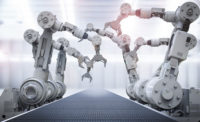Walmart, Bentonville, Ark., debuted a new Intelligent Retail Lab (IRL) in its Levittown, N.Y., location, complete with artificial intelligence-enabled cameras, interactive displays and a massive data center.
Walmart’s tech incubator Store No 8 positioned the store within one of the company’s busiest locations, testing new, innovative ideas within a real store containing over 30,000 items.
“We’ve got 50,000 square feet of real retail space. The scope of what we can do operationally is so exciting,” says Mike Hanrahan, chief executive officer of IRL. “Technology enables us to understand so much more – in real time – about our business. When you combine all the information we’re gathering in IRL with Walmart’s 50-plus years of expertise in running stores, you can create really powerful experiences that improve the lives of both our customers and associates.”
What’s inside IRL
IRL is set up to gather information about what’s happening inside the store through an array of sensors, cameras and processors. All this hardware is connected by enough cabling to scale Mt. Everest five times and enough processing power to download three years’ worth of music (27,000 hours) each second.
In short, the team will use real-time information to explore efficiencies that allow associates to know more precisely when to re-stock products, so items are available on shelves when they’re needed.
“Customers can be confident about products being there, about the freshness of produce and meat. Those are the types of things that AI can really help with,” Hanrahan says.
In IRL, for instance, a combination of cameras and real-time analytics automatically trigger out-of-stock notifications to internal apps that alert associates when to re-stock. To do so, the store has to automatically:
- Detect the product on the shelf.
- Recognize the specific product (meaning, decipher the differences between 1 pound of ground beef and 2 pounds of ground beef).
- Compare the quantities on the shelf to the upcoming sales demand.
The result is that associates won’t have to continually comb the store to replace products running low on the shelves. They’ll know what to bring out of the back room before customers show up.
Because there are many scenarios just like this to be tested, IRL will be in data-gathering mode in its early days, with a focus on learning from the technology vs. implementing changes to operations.
“You can’t be overly enamored with the shiny object element of AI,” Hanrahan adds. “There are a lot of shiny objects out there that are doing things we think are unrealistic to scale and probably, long-term, not beneficial for the consumer.”
The IRL experience
“We chose right from the very start to not hide the technology,” Hanrahan says.
As customers shop, they can interact with a number of educational displays. Small educational kiosks are interspersed throughout the store. A Welcome Center at the front end allows customers to dive deeper into technical specifications and common questions.
The Data Center, where the servers are housed within plexiglass windows, consists of two large displays – one of which encourages participants to move around and learn how technology reacts to body positioning.
The interactive wall is a fun demonstration of how AI can estimate body positioning.
Working in IRL
IRL’s more than 100 associates will be undertaking these retail experiments every day, getting a firsthand view of what’s possible for the future.
“We think it’s something our associates will be excited about,” Hanrahan says. “The technology has been built to improve associates’ jobs, to make their jobs more interesting, to help them alleviate some of the mundane tasks. AI can enhance their skillset in a very rapidly changing world.”



